This past weekend, I had a chance to fire an M1 Carbine I recently found in the bottom of a lake. My diving crew friends also recovered some ammo with the gun. Uncle Sam’s Lake City Army ammunition plant had loaded it almost 70 years ago. Stored in an ammo can in a detached garage for many of those years, the US government ammo ran flawlessly.
A couple of years ago I wrote here about how antique ammo stored even in less than ideal cool and dry conditions will still go bang reliably. Perhaps not as reliably as modern production ammunition, but pretty darned close.
Ammunition typically doesn’t go bad unless it’s exposed to oil contamination. Corrosive environments (such as being near an ocean), extreme heat, or perpetual high humidity take many decades to meaningfully erode the reliability of loaded ammo.

For those of us who store ammo in ammo cans, they do a nice job protecting cartridges from moisture and other issues.
This past weekend’s experience again proved that ammo will last longer than most people will, even when stored poorly. So don’t be afraid of firing factory-loaded ammo that has a “born on” date older than you on a headstamp.
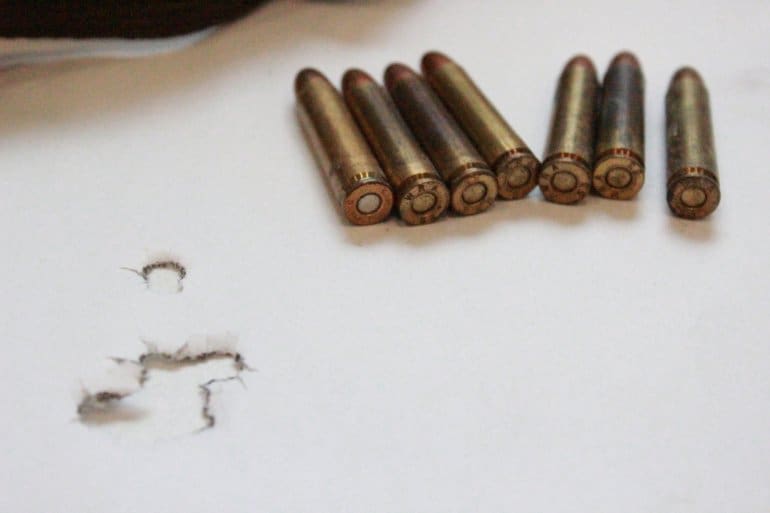
Not only that, but that antique ammo shot plenty accurately too, at least minute of bad guy.
In this case, I sighted in the rifle. Five clicks to the left on the rear sight put me dead-on at 25 yards. Then a follow-up 15-round magazine on a fresh target put all but one into a ragged, roughly one-inch hole. For the record, I called the errant round. The Rockola barrel shoots true with those antique rounds.
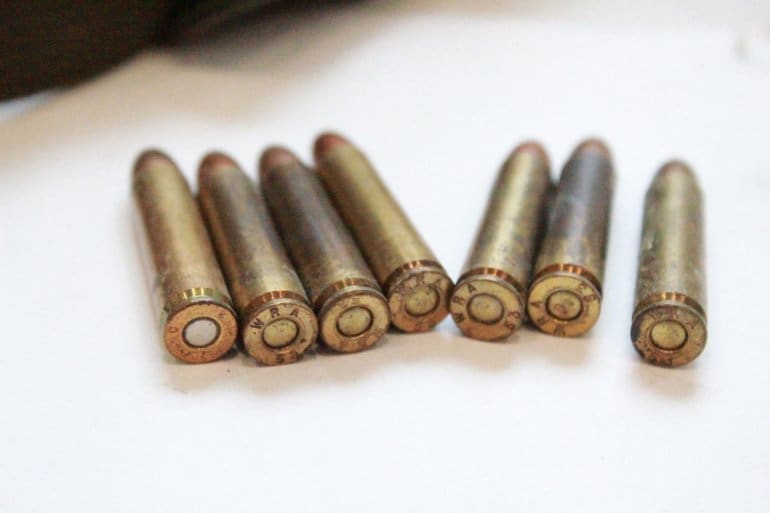
The only ammo that posed any issue was some custom-made defensive loads. The issue, however, had nothing to do with the rounds firing.
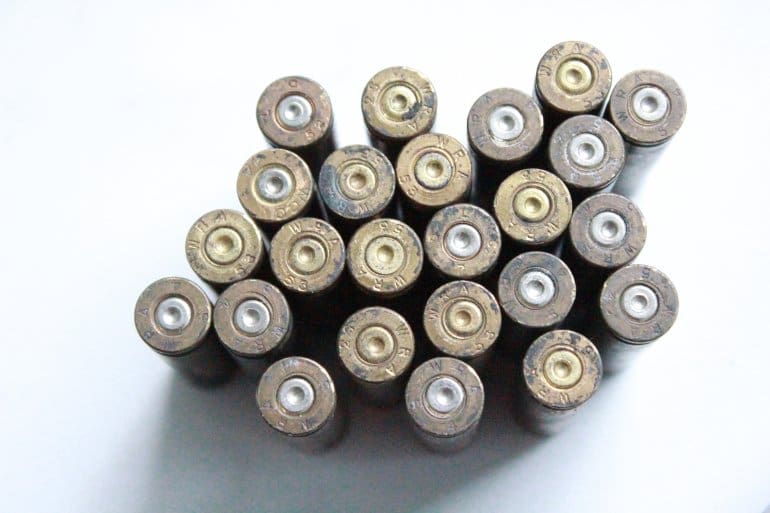
Someone had cast .30 caliber hollow-points and loaded them for use in the M1 Carbine. Those rounds didn’t feed reliably. Of the sixty cartridges (two loaded 30-round magazines), I managed to shoot a total of twenty rounds.
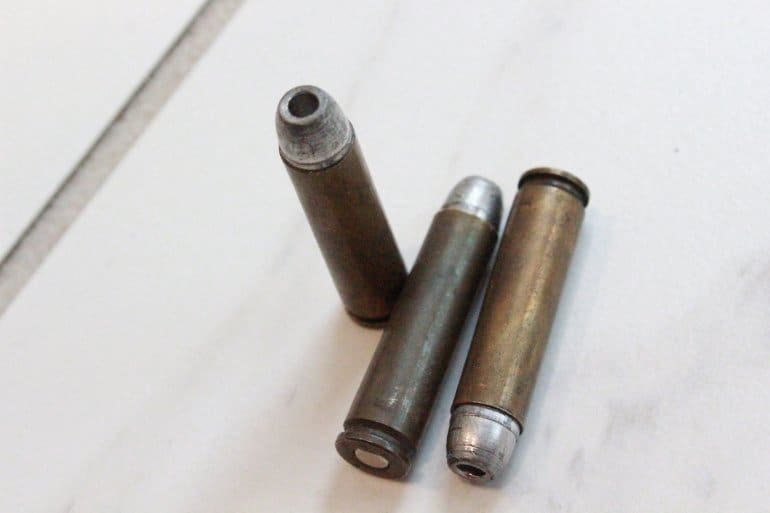
While shooting those, I suffered through at least that many rounds that wouldn’t feed even with some cajoling. Eventually, I chucked the rest in the trash. I did manage to find three loose ones for photos though.
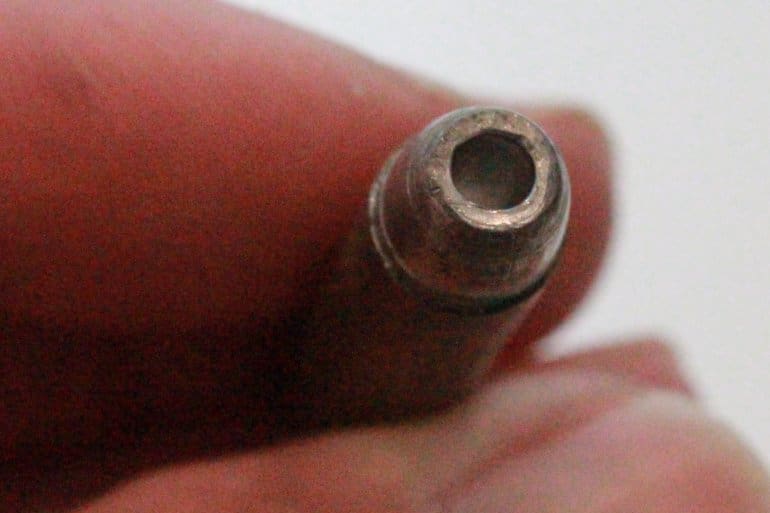
Somewhere along the line, a previous owner of that ammo spent good money probably in the 1960s or 1970s to make something they believed more effective for personal defense than ball or soft-point .30 caliber ammo.
Fortunately they never needed it because it wouldn’t have functioned for them, largely because of the shape of the bullet and the overall length of the loaded rounds. (Pro Tip: This is why we always function test ammunition and magazines we intend to use for personal defense.)

Speaking of which, I’m a fan of Hornady’s Critical Defense .30 Carbine defensive loads. They ran reliably in the 15-round magazines that came with the rifle from the bottom of Lake Michigan.
To sum up: shooting is fun. And shooting old ammo is fun, too.



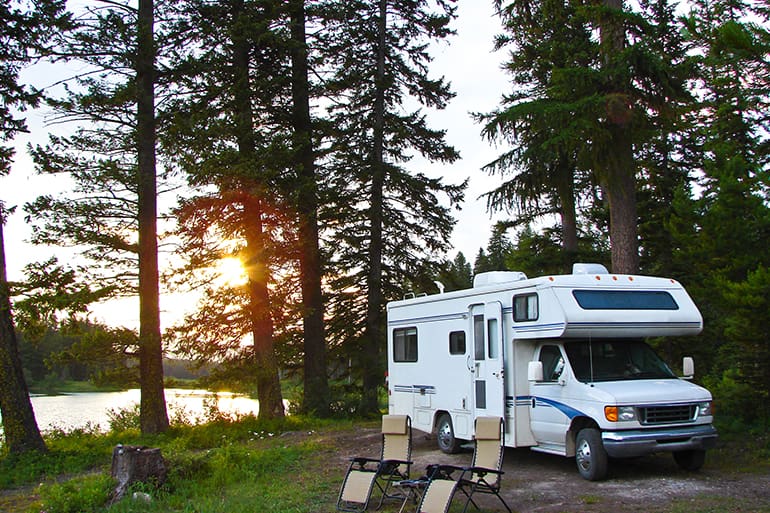

30-06 surplus from then and earlier used to be a quarter. it is now apparently worth $1 a round and that’s for corrosive….what a deal!
I have several crates of Turkish 8mm Mauser made in the early 1950s. Another crate of Albanian 7 62x54r. Not sure of the date but probably 60s or 70s. I have used 1950s KF .303.
All went bang when I pulled the trigger.
The takeaway here is to start diving
Especially since there have been an awful lot of tragic boating accidents in the last decade.
Magnet fishing?
LUCK N LUCKY , I WOULDN’T HAVE THAT KIND LUCK …
I was in the navy from 81- 88 all of the.45acp was wwII surplus. My grandchildren will be shooting my hand loads long after pawpaw is gone
I found a whole timber full of pawpaws the other day. Man they’re good, just gotta be careful about swallowing to many of the seeds🙂
Got several paw paw trees on my land. Taste like custard.
Oh my, you used actual emu that was actually designed for Weapons of War.
Let’s just hope the BATFE doesn’t find out this.
As long as the primer is sealed age should not be a problem.
Where does one get a firearm fishing license? Bureau of Billy Bass and Busch Light Control?
“Where does one get a firearm fishing license?”
Right here is a good start :
https://www.ebay.com/b/Fish-Magnet/119111/bn_7023300569
Knock yourself out! 🙂
I fired WW2 3 inch mortar ammunition out of 81 mm with firing pin adapter in 1980. It all went boom.
Had some 1948 steel case, steel jacket French 30-06 that I used for years to show people cars were not cover. In one side and out the other.
Ammo lasts longer than people think.
I’ve been shooting military surplus 30 cal ammo from the Korean conflict in my M1 carbines since the 80’s. Still have several thousand rounds, I bought back in the 80’s from at a surplus store in Quincy, Illinois.
That 150 year old Winchester lever action rifle, that was found I believe in the New Mexico desert, a few years back. Had a live round in it. It would have been interesting to see if that live round was still capable of being fired.
Black powder actually retains its oompah for a very long time. Civil war era cannonballs are still dangerous.
It would be the primer that would be a cause for concern. I think that rifle was found in Nevada?
This guy is nuts for shooting someone else’s reloads. It’s like eating pills you find on the sidewalk. It might be a tic-tack, M&M or fentanyl.
We don’t have enough moisture around here to corrode ammo. More’s the shame. The only good thing is it saves me from having to cut the grass–or what’s left of it.
I’d love to send you some of mine, we got our first significant rainfall two weeks after a 20 inch deluge from Ian and two inches of rain flooded my back yard and my street all over again. Nowhere for it to go as the ground is saturated.
My back yard was getting waist high with a warm winter and LOTS of rain. The mower broke when I tried to start it and there’s a 4 week backlog on repairs at the shop.
I was able to slash it down with the Ryobi line trimmer, battery powered. It will do for another week or 2.
By a sheep, and chain it to a cement block.
Keeps the traffic slowed down as well.
Cheaper than cops too.
:<D
By chance do you have pics of the carbine before and after? Love to see those.
I bought some .45 Auto surplus made in 1953 in sealed cans. Every round fired. It was like firing black powder, but it worked.
Fired the M1 my Grandpa left me with headstamped ammo ‘made in 44’ markings and over 95% fired just fine
I love that M1!!!!!!!!!!!
that ammo inventory reminds me of my man cave where I cling to my guns and my religion.
I heard so much .50cal ammunition was being used in the gulf and Afghanistan that stocks made in WW2 were being fired.
while I was over in Iraq, one of the trucks in my section had a M2 made by General Motors AC Spark Plug Division. That gun had been with Marines spreading Freedom…or hate and discontent depending on which side you were on since WW2.
Was the only .50 I saw with wooden charging handle and spades. All of ammo was new(ish) manufacturer though.
I read somewhere that the US made so many new m2’s during ww2 that we still had new in the crate guns in storage that were made in ww2. When new guns were needed in military inventory they were just hauled out and issued. Supposedly this was happening as late as the 90’s.
Not true. Almost no M2 Carbines we’re made during WWII. Most M2’s were converted M1’s. After WWII, during rebuild, most M1’s were converted to M2 configuration. These and newly manufactured M2’s were issued for the Korean War up through Viet Nam.
Diksum, jwm is referring to the M2 Browning HMG, not the M2 carbine.
So many M2s were made production was curtailed in late 1944 or early 1945.
Make sure to disassemble the carbine and thoroughly clean it and the gas system as a lot of that old ammo is corrosive.
Nonsense. Not recommended at all. In more than 20 years of Carbine collecting, I have never encountered corrosive .30 Carbine ammo. The design of the gas system requires non-corrosive ammo. The US never specified or acquired any. I never heard of anyone having a malfunctioning Carbine because of a fouled gas system. To disassemble the gas system requires a special tool, and really requires an armorer or gunsmith to do it right.
the army made those conversion kits in large numbers…many made their way into civilian hands…the idea was to give the average GI more firepower in the face of hordes of chinese…thus the 30 rd mag…the so-called “banana clip”….
I heard from somewhere, maybe one of my books, the M1 Carbine ammunition was non-corrosive and boxer primed.
No 30 carbine ammo ever made was corrosive.
Back around 1958 I tried shooting WWII Japanese ammo in a Nambu pistol. Nothing fired. As a kid not knowing what I was doing, I filed the firing pin into a point sharp enough to puncture the primer. Only then did anything fire, but the rounds just traveled about 20 feet. This stuff was probably no more than 20 years old.
Late war production with alternative components?
Yes, late war production probably. It was some really bad ammo. Worked ok when it was brand new but after a few months in storage or use in the field the components degraded because of moisture ingress around the primers and bullets because the material was of such poor quality. By the late war Japan was relying almost completely on any materials it could get ,especially from Germany, for ammunition materials, and Germany sent the Japanese inferior materials and kept the best stuff for Germany and Japan its self was putting more inferior materials it had into ammunition.
surprising how often concern is shown in regards to “old” ammo.
kid i work with was ready to toss his dad’s service .38 rounds- i told him go enjoy.
picked up an old mossberg .22 face to face, before the new restrictions (wink and a handshake, dad’s old rotc arm at lane tech, public trans, etc.). he mentioned dropping off the old montgomery wards and other vintage boxed stuff at the police station for disposal. i relieved him of his burden.
I have several hundred rounds of rebox wwll surplus .45 dated 44 don’t remember mfg.
shoots fine but corrosive as hell. think the barrel starts rusting before the bullet gets to the target. gun show find, bought all he had for a song sometime in mid 90s
I have had WWI ammo that still fired off. I had a hang fire with a few but the majority fired with no problem.
WWI ordinance in Europe is still working its way out of the ground and most fires off when it is recovered and destroyed by the bomb disposal experts.
That carbine looks pretty good for having been under water. Must have been there no more than 15 minutes. Or… could Mr. Boch possibly be pulling my leg?
My impression also.
This is good news as there are some people in Eastern Europe finding a lot of ammo poorly stored in bunkers, open fields, schools and private homes who want to know if they can use it for various purposes.
I have some pre-WW2 7.62x54R that still goes bang every time. Old ammo doesn’t die easily if it’s not infiltrated by oil.
This ammo is corrosive, but proper maintenance protects the old guns. Some of my rifles are older than I am, and they will still shoot long after I’m gone.
THatbrifle has never been atbthe bottom of lake unless in a sealed container for more than a day the metal work and especally the woodwork look hardly usedeven the mags were still blued as far as I can see.
But I canvouch for old ammo . Back in 1969 I was tthe STATION ARMOURER at RAF CREDENHILL in HEREFORD UK and wee found tow packing cases tucked away in ‘stores’ that contained 6x LeeEnfield Rifles from thw WW1 era that had been put aside for the local Police Force. In each case was 100rds or so .303 ammunition dated from 1917. THe Rifles had been greased up reasonably well butbthe ammonwe took down to a ourranges and that too firede oervectly well . The Rifles we dcxe-greased and it bec\aame obvious that they were Veterans to say the least and they had been fobbed off on the Police at some time so we exchanged them for New No4’s and latest issue .303 and took the lot on inventory. I informed the Local Constabulary and they had no idea they even had access to them. The ‘Original Rifles I sent back to the RAF Stafford Dept and I think they were turned into Wall Pieces
More like you were the armorer at Cretin Hall, in Her Majesty’s Home For Mentally Retarded Orphans. And, your Nerf guns aren’t at all like real guns.
Comments are closed.